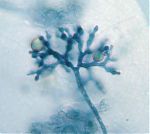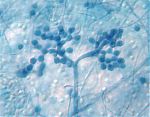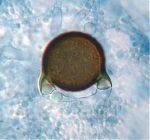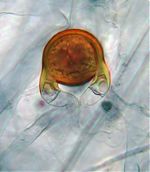Kuzuhaea
KUZUHAEA Benjamin, 1985 (Journal of the Linnean Society, Botany 91:122); 1 species (Benjamin, 1985).
Haustorial parasite of Mucorales. Sporangiophore simple or dichotomously branched. Merosporangia formed by acropetal budding, dichotomously branched, moniliform, septa formed and then disarticulate at constrictions. Spores globose to triangular in shape, ornamented by small spines. Zygospores more or less globose, zygosporangial wall; suspensors apposed, initially parallel, at maturity tongs-like; azygospores also present. Homothallic
Type species: K. moniliformis
Species of Kuzuhaea:
K. moniliformis R.K. Benjamin, 1985 (Journal of the Linnean Society, Botany 91:122) (Benjamin, 1985).
Kuzuhaea moniliformis (Benjamin, 1985) was isolated from soil collected in Tokyo, Japan; it is only known from the initial collection. It is similar to Piptocephalis in many characteristics although branched merosporangia are not known in the latter genus. A host is required for growth of K. moniliformis beyond germination of spores. Benjamin (1985) compared K. moniliformis with other genera (Piptocephalis, Syncephalis) in the Piptocephalidaceae.
Kuzuhaea was grown on the host fungus Umbelopsis ramanniana with one-fifth strength YpSs agar as the culture medium. The relatively nutrient-poor 20% YpSs agar was used to grow K. moniliformis so that ontogeny of the fungus could be observed.
Bibliography
Benjamin, R.K. 1985. A new genus of the Piptocephalidiaceae (Zoopagales) from Japan. Bot. J. Linn. Soc. 91: 117-133.
Updated Nov 07, 2007




